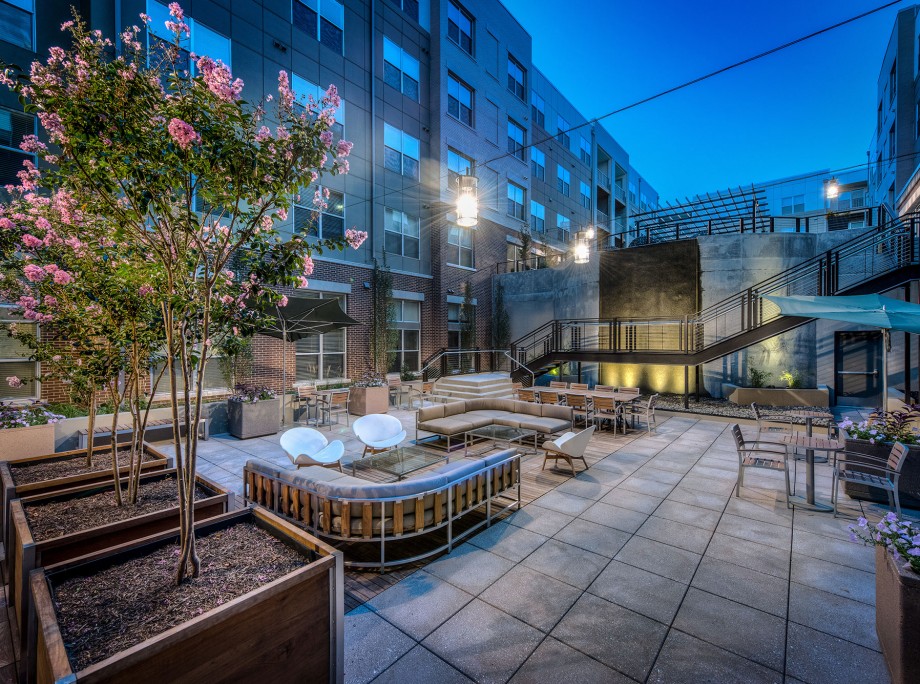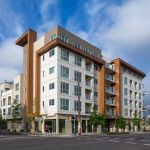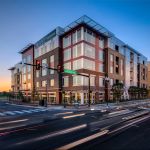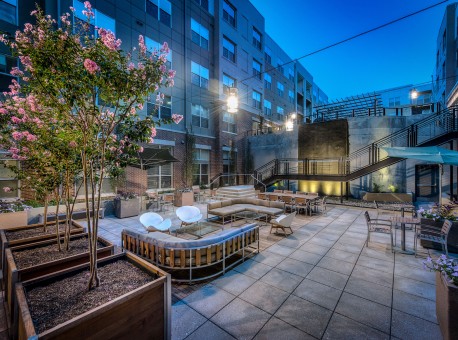Rohit Anand – 2016 Design Trends
Multi-Housing News
January 30, 2016
Design Trends 2016
By Nancy Crotti, Contributing Editor
The current apartment building boom has more to do with socializing and less with having a place to eat or sleep, at least for Millennials. Baby Boomers, who are trading their single-family homes for urban apartments or suburban units near the grandkids, want to socialize and have ample living space.
Apartment Design
Developers are very happy to oblige, with social amenities in the lobby, in the courtyard and on the roof. Pools, lazy rivers and outdoor gathering spaces draw residents into the open, while collective workspaces, coffee shops/cafes, and wine and beer bars pull them indoors.
Pet owners have washing stations and dog parks. Some companies are building drone landing pads for the day they hope the Federal Aviation Administration will allow Amazon and Domino’s to deliver to the roof. The relatively new phenomenon of the package room to hold non-perishable deliveries now has an adjunct: cold storage for groceries.
All these amenities keep renters signing up and coming back, according to industry experts. The social aspect works particularly in developers’ favor, according to Mark Humphreys, CEO of Humphreys & Partners Architects, an international architecture firm based in Dallas. The more neighbors an apartment dweller meets, the more likely she is to renew, he said. For example, residents of the 278-unit Cortona at Forest Hills in St. Louis gather for a weekly happy hour on Thursdays for free beer and wine.
“Most everybody tries to be there,” Humphreys said. “They get to meet each other. They have friends over.”
The typical bike wash and repair room has turned into a “bike-and-board pub” complete with repair stations, a keg and coffee bar, and a TV lounge, according to architect Cindy Harvey of Kephart in Denver. “This creates an atmosphere where people who enjoy the same activities can connect. The more friends and people you know in the community, the more likely you are to stay.”
The concept of shared space has spilled over from the workplace into places people call home, Harvey added. Gone are the static, sterile business centers with three computers and a printer. Collaborative work and meeting spaces, popular with those who work from home, have replaced them.
Retail and/or dining, a first-floor requirement in some cities, have historically had separate entrances from those used by residents. Now developers have begun to integrate them into the lobbies and leasing areas, according to Harvey and Rohit Anand, a principal in the Tysons, Va. office of KTGY Architecture + Planning.
“It kind of becomes a hotel lobby experience” where residents and the public can relax in soft seating, said Anand. For resident security, a strategically placed concierge makes sure that the public has no access to elevators, he added. Don’t look for coffee shop chains in these lobbies, however. “Authenticity is the big thing these days, especially with the Millennials,” Anand said. “It’s generally a local operation that they look for.”
Even pools have changed.
The Cortona in St. Louis has a lap pool, preferred by Boomers, and a tanning ledge, favored by Millennials, Humphreys said. Other pool area amenities include a hot tub, outdoor grills, a bar and cabanas. The Cortona’s pool is in its courtyard, but Humphreys is finding a strong demand for rooftop pools and fireplaces.
In San Jose, his firm has designed top-floor townhome units with private stairs and private rooftop patios. In Nashville, some units have private pools, either fenced in on the ground floor or extending from the balcony of a high-rise. Humphreys is also trading some ground-level units for what he calls “The Cave,” a semi-outdoor gathering spot for small groups to watch TV and socialize.
“It’s kind of a hook,” he explained. “When the leasing agents are showing people around, they go, ‘Would you like to see The Cave?’”
Living units are also evolving, and not just for humans. National firm BSB Design is taking pet amenities into apartments with its “pet pod,” a mini washroom with a tiled floor, drain, and space for a dog kennel. BSB typically locates the pet pod next to the laundry room in a two-bedroom apartment, and near the kitchen in a one-bedroom unit, according to Kelly Osburn, market leader at BSB’s Dallas regional office.
The pods have met with a tremendous response from tenants, Osburn said. Apartments with pet pods are under construction in California, Illinois, Nevada, Ohio, Texas and Washington, D.C. BSB has also designed pet pods for existing units in Class B and C buildings in California, Osburn added.
In addition, BSB is drawing up units with smaller closets (8’x7’ vs. 10’x10’) that residents can customize using commercially available organizing systems. For urban kitchens, BSB is recommending black stainless steel appliances and sleek cabinets with glass panels and interior lighting. Osburn said he has also been experimenting with combination washer-dryers to save space.
In the kitchen, granite counters have become passé, according to Humphreys. His company has switched to epoxy counters embedded with chunks of broken windshields and colorful glass bottles. They’re stronger than granite and cost the same, he added.
For Millennials, who tend to eat out frequently, BSB designs kitchens to mimic those found in extended-stay hotel suites, with two-burner stoves, 24-inch refrigerators and no dishwasher units.
Millennials and Baby Boomers share some priorities in choosing their apartments. Both want walkable urban areas with dining and cultural attractions, according to Anand. Boomers prefer larger, luxury units that give them the ability to “lock and leave” for travel, “but if it’s well designed, they’re willing to give up some of these things like size of the apartment to be in a desirable location,” he added.
Anand has found that some Boomers age 65 and older favor apartments in master-planned suburban communities where their children and grandchildren live. These apartments are larger than those in cities and have a more single-family-home feeling, with mudrooms, laundry rooms, foyers and walk-in closets.
With so many apartment buildings recently opened or under construction, some landlords have hired branding consultants to help their buildings stand out. For an infill project in a neighborhood known for its creative, entrepreneurial denizens, one consultant created a brand narrative for independent-minded, tattooed residents who want their apartment building to feel much like their favorite jeans and T-shirt, according to Harvey.
Kephart used tumbled brick for the base of the building, with stucco and panel siding above to achieve a clean, comfortable look. The owner commissioned a local artist to create a mural styled after the color palette and print media created for the building’s brochures and website. “It really came across as a seamless package with a solid identity,” according to Harvey.
In general, the urban look prevails for building facades in cities and suburbs, said Osburn. Lighting has become particularly important, with LED lights creating options for color, including changing colors. Combined, these design points give residents a sense of arrival at their building, as if they’re coming home to a boutique hotel every evening.
“That’s an experience they’re willing to pay for,” Osburn said.
 Rooftop amenities attract renters in Portland, Ore., to Linden Apartments designed by KTGY Architecture + Planning for Foursquare. Photography © Jeff Amram
Rooftop amenities attract renters in Portland, Ore., to Linden Apartments designed by KTGY Architecture + Planning for Foursquare. Photography © Jeff Amram
Rooftop amenities also pay off nicely and benefit all residents, not just those who can afford a private penthouse view, according to Humphreys. For a 52-story tower in Jersey City, N.J., where an outdoor pool would be unfeasible, his firm designed an enclosed rooftop space where all residents can have “a poster view of Manhattan.”
“Depending on the location, you can get 5 more cents to 20 more cents rent per square foot on your property giving everyone that rooftop view,” he said. “That way overpays for the rooftop situation.”
Developers can realize capitalization rates of 6.5 percent in many markets, and cap rates in the 5 percent range in the San Francisco Bay area, noted Anand. Residents may justify paying higher rents if they can use the building’s co-working space for meetings instead of renting an office, and work out with a trainer or in a fitness class in the building rather than joining a gym, added Harvey.
Her firm has also been working with owners of older buildings to compete with all the new construction.
In a 1918 bank building adaptive reuse project, Kephart preserved the main banking hall as a stunning leasing area and great room for the surrounding apartments, she said. Architects can give older buildings with less spectacular interiors new life by opening up spaces for better flow and socializing.
“The difference is astounding,” Harvey noted.
Regardless of their age, apartment buildings should be in walkable neighborhoods and have amenities that promote connecting with other residents, she added. “These should be components of every project and could go a long way to improve our land use and development patterns of old,” Harvey said.
However, she cautioned against over-generalizing about the generations when it comes to renter choices. Millennials will eventually want to move into more family-friendly homes, while many Boomers are opting to adapt their homes so they can age in place rather than move into the city, Harvey said.
“My recommendation is, get a market report, target your market, and do your research about their preferences and trends,” added Harvey. “And don’t be surprised if some other demographics like what you’re doing and show up.”



